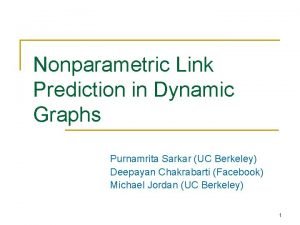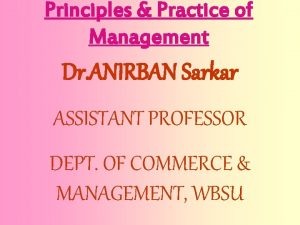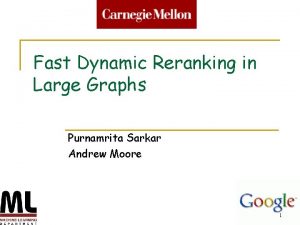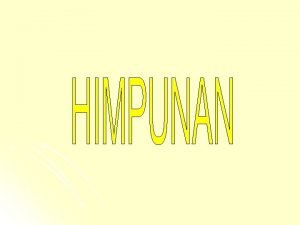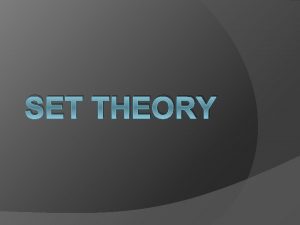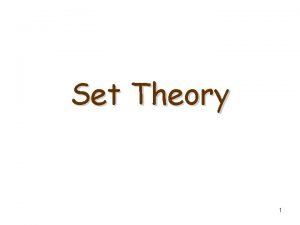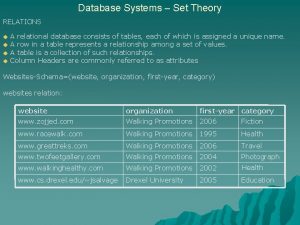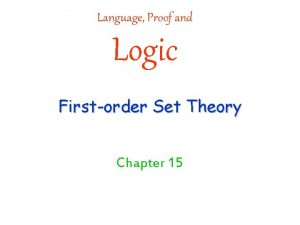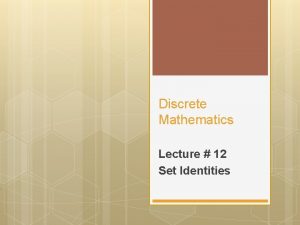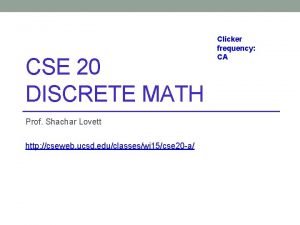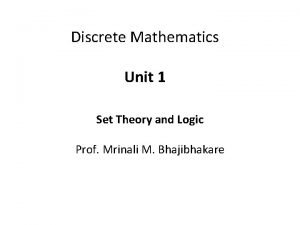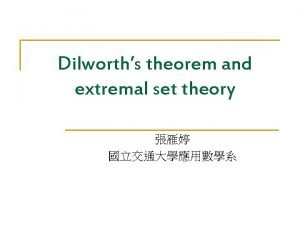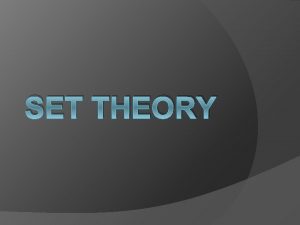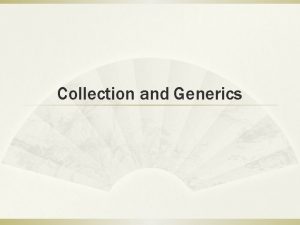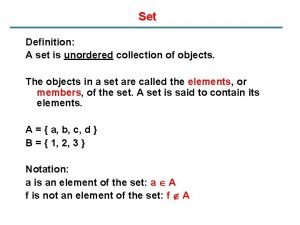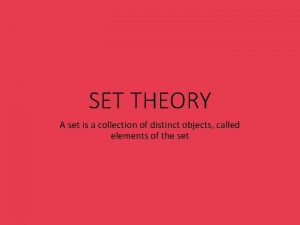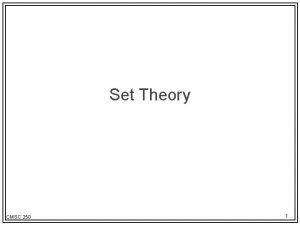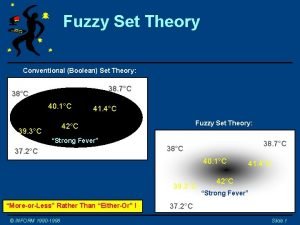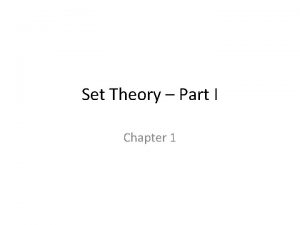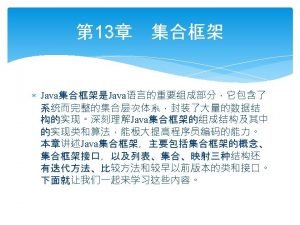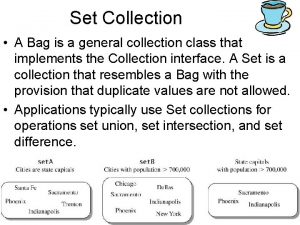SET THEORY Chumki Sarkar Definition A collection of





























- Slides: 29

SET THEORY Chumki Sarkar

Definition: �A collection of objects is defined to be a set when � (i) the collection is well-defined; � (ii) objects belonging to the collection are different; � (iii) objects of the collection are independent of the order of their arrangement Chumki S arkar Presented by: Chumki Sarkar, Maheshtala College 30 -09 -2020

METHODS OF SET PRESENTATION Presentation of Set ROSTER or TABULAR METHOD PROPERTY or SET-BUILDER METHOD Chumki Sark ar Presented by: Chumki Sarkar, Maheshtala College 30 -09 -2020

ROSTER METHOD � The set is described by just listing its elements inside brackets. � Ex: the set of all vowels of the English alphabet A={a, e, i, o, u} � Demerits: This method fails if all the elements of the set cannot be displayed. In that case the property method is used. Chumki S arkar Presented by: Chumki Sarkar, Maheshtala College 30 -09 -2020

PROPERTY OR SET-BUILDER METHOD � The set is described as A={x/P(x)} where x is any element possessing the property P(x). � Ex: The set of all prime numbers is described as A={x/x is a prime number} Chumki Sarkar Presented by: Chumki Sarkar, Maheshtala College 30 -09 -2020

SINGLETON SET �A set consisting of only one element is called singleton set. � Ex: A={4} Chumki Sa rkar Presented by: Chumki Sarkar, Maheshtala College 30 -09 -2020

NULL SET �A set which contains no elements at all is called null set or empty set or void set. It is denoted by Φ( Phi). � Ex: Φ={x: x is an integer and 2<x<3} Chumk i Sarkar Presented by: Chumki Sarkar, Maheshtala College 30 -09 -2020

FINITE AND INFINITE SETS �A set is said to be finite if the number of elements contained in the set can be counted and the counting process has an end. Ex: A={10, 11, 12, 13, 14, 15} i. e. n(A)=6 �A set is said to be infinite if the number of elements contained in the set can not be determined by counting. Ex: A={1, 1/2 , 1/3 , 1/4 , . . . } Chumki S arkar Presented by: Chumki Sarkar, Maheshtala College 30 -09 -2020

EQUAL SET � Two sets A & B are said to be equal if all the elements of A are the elements of B as well as all the elements of B are the elements of A and written as A=B Example: A={1, 2, 3, 4} B={2, 4, 1, 3} Chumki Sar kar then A=B Presented by: Chumki Sarkar, Maheshtala College 30 -09 -2020

UNIVERSAL SET �A set U is called Universal set if all the sets under consideration are the subsets of U. Example: U={1, 2, 3, 4, 5, 6, 7, 8, 9} A={2, 4, 6, 8} 5 1 2 3 Chumki Sar kar 8 A 4 : Universal Set : Subset U 7 6 Presented by: Chumki Sarkar, Maheshtala College 9 30 -09 -2020

SUB SET A B Examples: �A “A is a subset of B” if and only if every element of A is also an element of B. = {3, 9}, B = {5, 9, 1, 3}, A B U A Chumki Sark ar B Presented by: Chumki Sarkar, Maheshtala College 30 -09 -2020

DISJOINT SET Two sets A & B are said to be disjoint if they have no common elements. Example: A={1, 2, 3} & B={4, 5, 6} A Ch umki Sar k ar U B Presented by: Chumki Sarkar, Maheshtala College 30 -09 -2020

UNION OF TWO SETS � The Union of two given sets A & B written as A ⋃ B is defined to be the set of all elements which belong either to A or to B or to both. Example: A={1, 2, 3, 4} & B={3, 4, 5, 6} then, A ⋃ B = {1, 2, 3, 4, 5, 6} U A Chumki Sarkar B Presented by: Chumki Sarkar, Maheshtala College 30 -09 -2020

INTERSECTION OF TWO SETS � The intersection of two sets A & B written as A ⋂ B is the set of all elements which belong to both A & B Example: A={1, 2, 3, 4} & B={3, 4, 5, 6} then, A ⋂ B = {3, 4, } U A Chumki Sarkar B Presented by: Chumki Sarkar, Maheshtala College 30 -09 -2020

DIFFERENCE OF TWO SETS � The difference between two sets A & B written as A-B is the set of all elements which belong to A but which do not belong to B Example: A={1, 2, 3, 4} & B={3, 4, 5, 6} then, A - B = {1, 2} U A Chumki Sarkar B Presented by: Chumki Sarkar, Maheshtala College 30 -09 -2020

COMPLEMENT OF A SET � The compliment of a set A written as is the set of all elements of the universal set U which do not belong to A Example: A={1, 2, 3, 4} & U= {1, 2, 3, 4, 5, 6, 7, 8} then, = {5, 6, 7, 8} U A Chumki Sarkar Presented by: Chumki Sarkar, Maheshtala College 30 -09 -2020

LAWS OF SET OPERATIONS Commutative Laws Associative Laws Distributive Laws De Morgan’s Laws Chumki Sarkar for any two sets A & B for any 3 sets A, B & C i) A⋃B = B⋃A, ii) A⋂B = B⋂A i) A⋃(B⋃C)=(A⋃B)⋃C, ii) A⋂(B ⋂C)=(A⋂B)⋂C for any 3 sets A, B & C i) A⋃(B⋂C)=(A⋃B)⋂(A⋃C), ii) A⋂(B⋃C)=(A⋂B)⋃(A⋂C) for any two sets A & B i) (A⋃B)C =AC⋂BC ii) (A⋂B)C=AC⋃BC Presented by: Chumki Sarkar, Maheshtala College 30 -09 -2020

Commutative Laws = = Chumki Sarkar Presented by: Chumki Sarkar, Maheshtala College 30 -09 -2020

Associative Laws (i) Chumki Sarkar Presented by: Chumki Sarkar, Maheshtala College 30 -09 -2020

Associative Laws From equation (i) & (ii) Chumki Sarkar (ii) Presented by: Chumki Sarkar, Maheshtala College 30 -09 -2020

Associative Laws Chumki Sarkar Presented by: Chumki Sarkar, Maheshtala College 30 -09 -2020

Associative Laws Chumki Sarkar Presented by: Chumki Sarkar, Maheshtala College 30 -09 -2020

Distributive Laws Chumki Sarkar Presented by: Chumki Sarkar, Maheshtala College 30 -09 -2020

Distributive Laws Chumki Sarkar Presented by: Chumki Sarkar, Maheshtala College 30 -09 -2020

Distributive Laws Chumki Sarkar Presented by: Chumki Sarkar, Maheshtala College 30 -09 -2020

Distributive Laws Chumki Sarkar Presented by: Chumki Sarkar, Maheshtala College 30 -09 -2020

De Morgan’s Laws Chumki Sarkar Presented by: Chumki Sarkar, Maheshtala College 30 -09 -2020

De Morgan’s Laws Chumki Sarkar Presented by: Chumki Sarkar, Maheshtala College 30 -09 -2020

THANK YOU Chumki Sar kar Presented by: Chumki Sarkar, Maheshtala College 30 -09 -2020
 Chumki sarkar
Chumki sarkar Total set awareness set consideration set
Total set awareness set consideration set Training set validation set test set
Training set validation set test set Purnamrita sarkar
Purnamrita sarkar Djordjevic-sarkar
Djordjevic-sarkar Nnnmodel
Nnnmodel Dr anirban sarkar
Dr anirban sarkar Purnamrita sarkar
Purnamrita sarkar Purnamrita sarkar
Purnamrita sarkar Landsat collection 1 vs collection 2
Landsat collection 1 vs collection 2 D/a 30 days after sight
D/a 30 days after sight Unordered collection of objects
Unordered collection of objects Contoh himpunan huruf
Contoh himpunan huruf A collection of well defined objects is called
A collection of well defined objects is called Bounded set vs centered set
Bounded set vs centered set Crisp set vs fuzzy set
Crisp set vs fuzzy set Crisp set vs fuzzy set
Crisp set vs fuzzy set Crisp set vs fuzzy set
Crisp set vs fuzzy set What is the overlap of data set 1 and data set 2?
What is the overlap of data set 1 and data set 2? Surjective vs injective
Surjective vs injective Himpunan logika informatika
Himpunan logika informatika Cardinal number of a set
Cardinal number of a set Joint sets symbols
Joint sets symbols Bc scientific notation
Bc scientific notation Set theory in database
Set theory in database Set theory
Set theory Proving set identities examples
Proving set identities examples Set theory practice
Set theory practice Set theory and logic discrete mathematics
Set theory and logic discrete mathematics Dilworth's theorem
Dilworth's theorem





